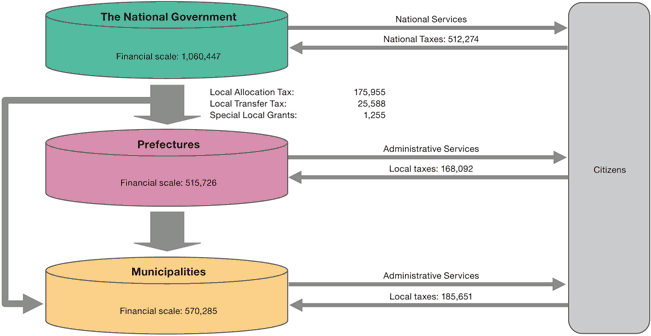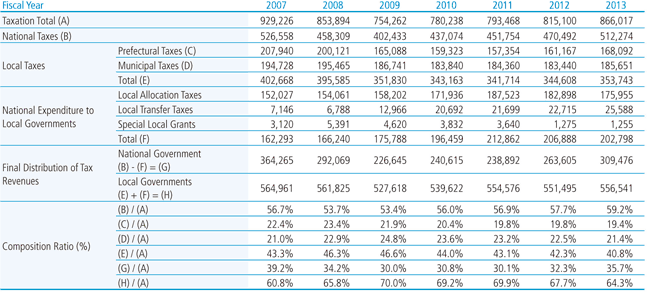TOKYO'S FINANCIAL SYSTEM
Financial Structure of Local Governments in Japan
The administrative system of Japan has a three-tiered structure: the top tier is the national government, and below that are the two tiers of local governments—prefectures and municipalities.
With the exception of administrative functions such as foreign relations and national defense, most of the administrative functions are financed both by the national government and local governments. Many of the national policies and programs are carried out by local governments.
In fiscal 2013, net total expenditure by the national government and local governments amounted to 69.1064 trillion yen and 96.6444trillion yen, respectively. The scale of expenditure by local governments reached approximately 1.4 times that of the national government; this figure shows how extensive a role local governments play in the public administration of Japan.
The total amount of tax collected in fiscal 2013was 86.6017 trillion yen, of which national taxes accounted for 59.2% and local taxes, 40.8%. However, the ultimate allocation of this revenue was 35.7% to the national government and 64.3% to the local governments. This is because about 40% of the taxes collected as national tax are distributed to local governments through systems such as the local allocation taxes, local transfer taxes, and special grants to local governments.
Structure of Local Finance in Japan (Unit: yen100 millions, FY2013)

Revenue
Looking at the breakdown of revenue for local governments (FY2013), local taxes made up the largest proportion at 35.0%, followed by local allocation tax (17.4%), national treasury disbursements (16.3%), and local bonds (12.2%). In more detail, the sources of revenue for local governments are as follows:
Local Taxes
These are collected by local governments, and the key source of revenue to carry out policies that meet local needs.
Local Transfer Taxes
Local transfer taxes are national taxes of which a fixed proportion of revenue collected is transferred to the local governments. Local transfer tax is an umbrella term covering taxes such as the local gasoline, special tonnage, petroleum and gas, automobile weight, aircraft fuel, and special local corporate transfer taxes. As part of revisions to the tax system in fiscal 2016, the national government decided to abolish the special local corporate tax, which has been transferred to local governments as an interim measure, when the consumption tax rate is raised to 10%.
Local Allocation Taxes
These taxes form the core of the local financial adjustment system of the nation. The system is designed to sustain general revenue sources and to correct fiscal imbalance among local governments, thereby ensuring that all local governments are able to provide an adequate level of services. This general revenue source consists of grants to local governments calculated by a fixed formula, which allocates a percentage of revenues collected nationally. The percentage of revenue allocated to local governments is 33.1% of income tax, 50% of liquor tax, 33.1% of corporation tax, 22.3% of consumption tax, and 100% of local corporation tax.
National Treasury Disbursements
These include allotments disbursed by the national government to local governments on the basis of the cost allotment classifications of the national government and local governments; mandatory cost sharing; consignment costs; and subsidies for the promotion of specific policies and support for public finances.
Local Bonds
This is revenue from bonds issued by local governments to defray the cost of constructing public facilities such as roads and schools. These are costs that should be spread over a number of years to have generations of residents benefitting from their construction share the burden equally.
Distribution of Taxes (Unit: yen100 million)

- Note 1:
- Total figures may not equal the sum of components due to rounding.
- Note 2:
- For FY2009 and earlier years, figures in “Special Local Government Grants” also include other special grants.
Expenditure
The breakdown of local finance expenditure by administrative category during fiscal 2013 shows major categories include social welfare accounting for 24.1%, followed by education at 16.5%, and civil engineering works at 12.4%. Social welfare and education combined amounted to about 40% of total expenditure.
The main items of expenditure of local governments are as follows:
Social Welfare
This expenditure provides social welfare services, including the development and operation of welfare facilities for children, the elderly, and people with disabilities, and serves to implement programs to provide public assistance, etc.
Public Health and Sanitation
The purpose of this expenditure is to maintain and promote the health of residents and improve the living environment. Funds go to carry out various medical policies, public health and mental health programs, sewage treatment, refuse collection and disposal, and measures to control pollution.
Agriculture, Forestry, and Fisheries
The purpose of this expenditure is to promote agriculture, forestry, and fisheries, and to maintain a stable supply of foods. Funds go to develop the production infrastructure, improve the industrial structure, take measures related to consumption and distribution, and develop and promote agricultural, forestry, and fisheries technologies.
Commerce and Industry
This expenditure is for the promotion of local commerce and industry, and to help companies update and streamline operations. Funds go to guide and develop small and medium-sized enterprises, to attract companies to local areas, and to carry out consumption and distribution measures, among others.
Civil Engineering Works
This expenditure is for development of the local living environment and urban infrastructure. Funds go to construct, develop, and maintain public facilities such as roads, rivers, housing, and parks.
Education
Education is one of the basic administrative areas of local governments. Expenditure is made toward furthering education and culture through schools and social education programs.
Debt Services
This expenditure is made for the redemption of capital and interest from the issue of local bonds.














